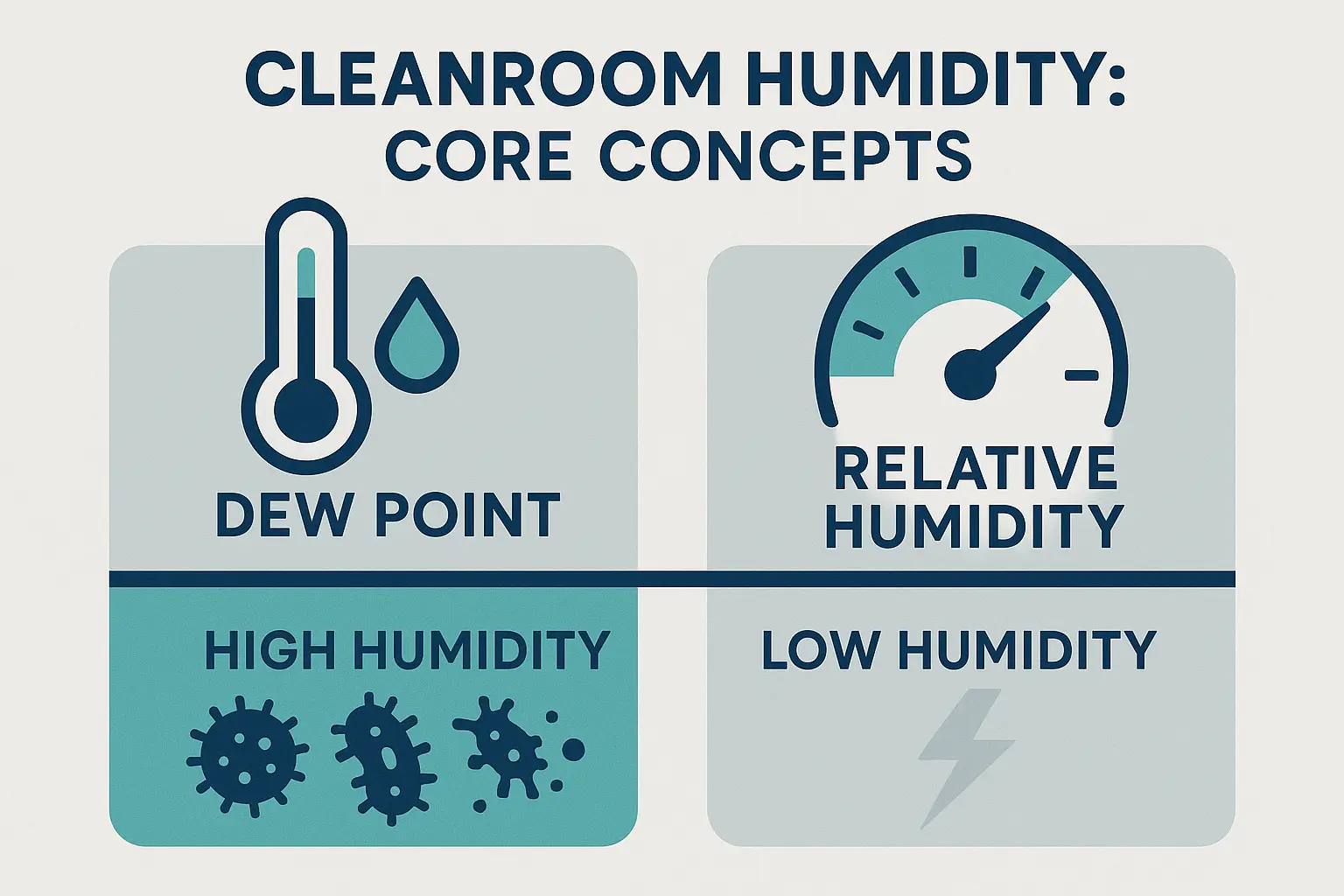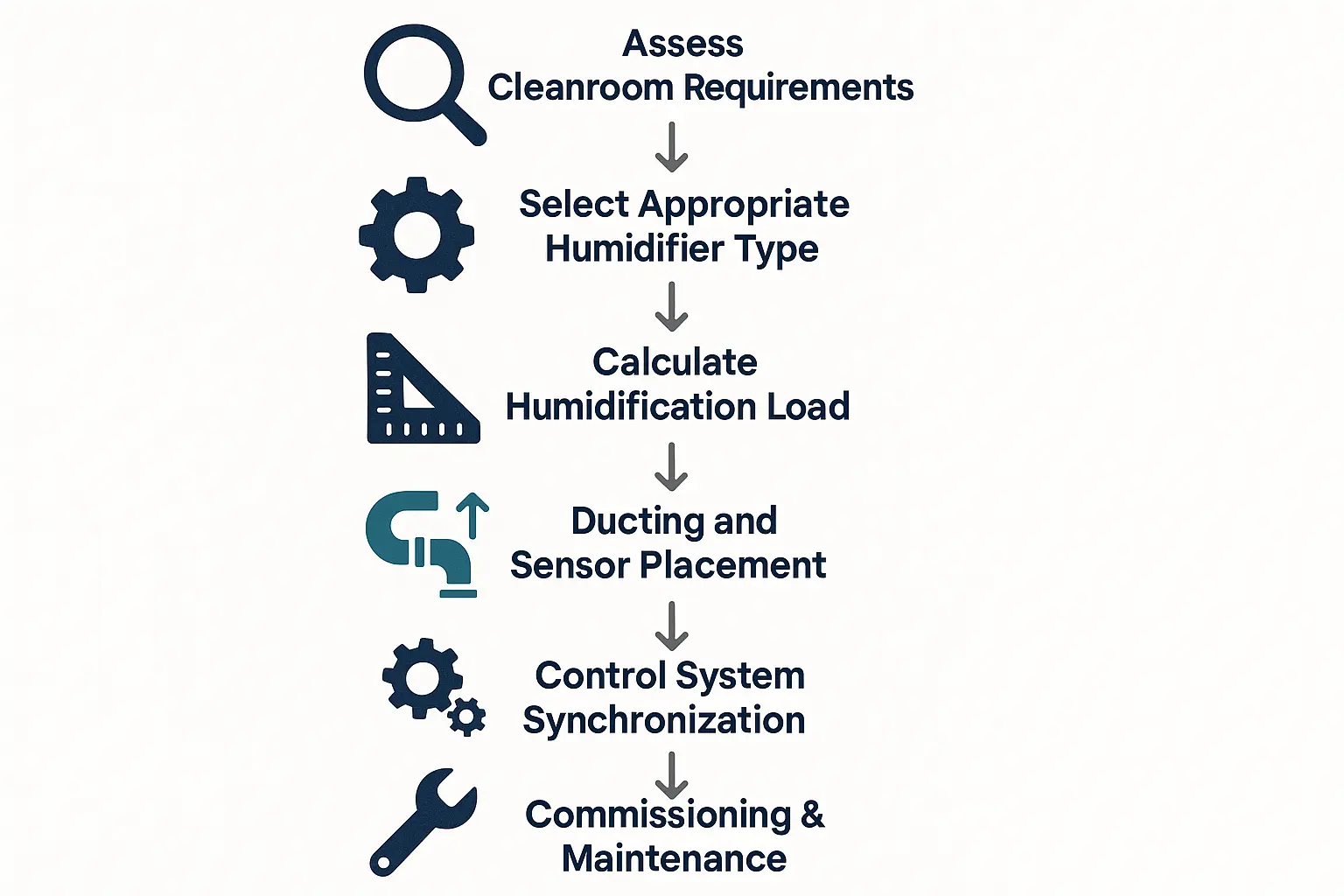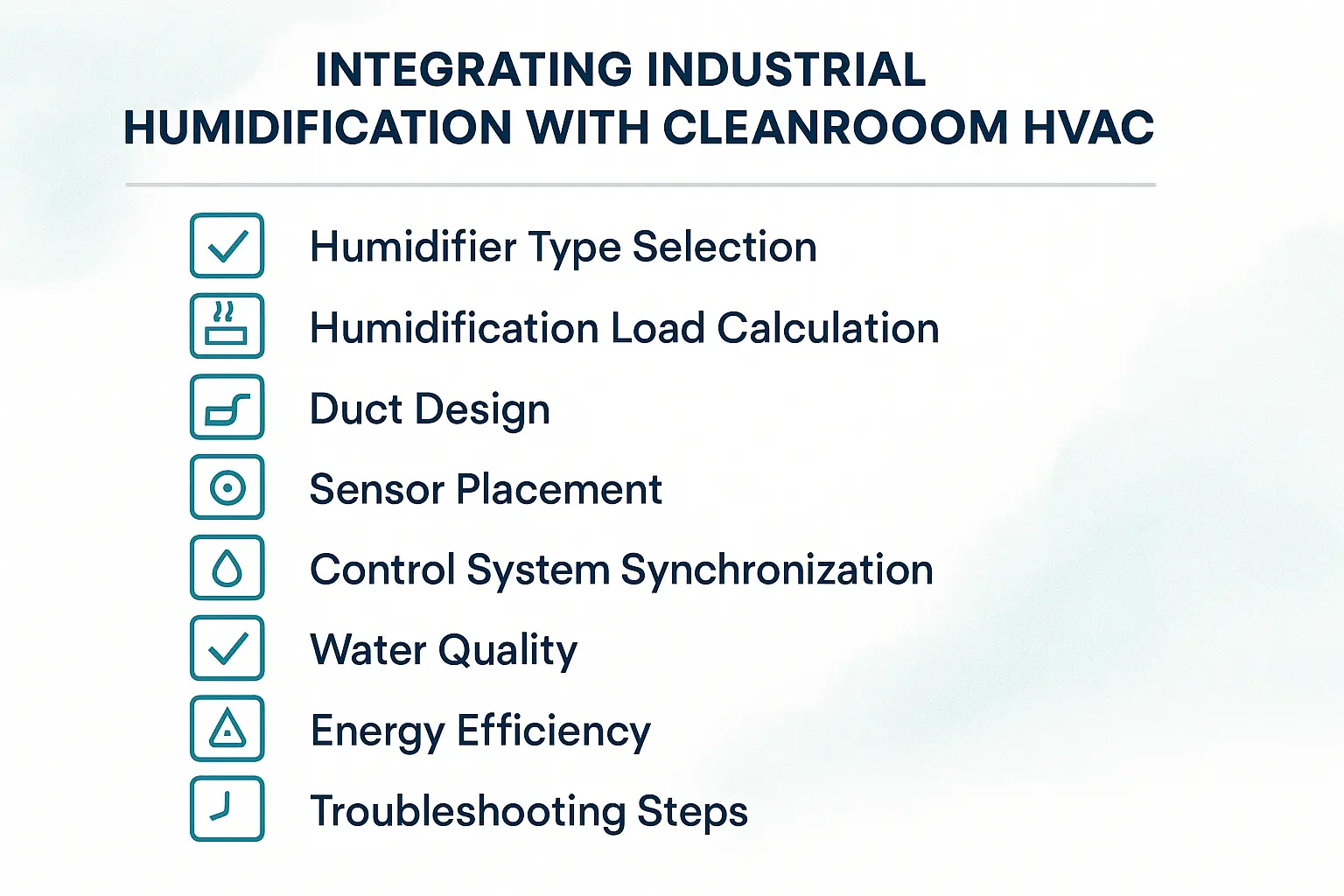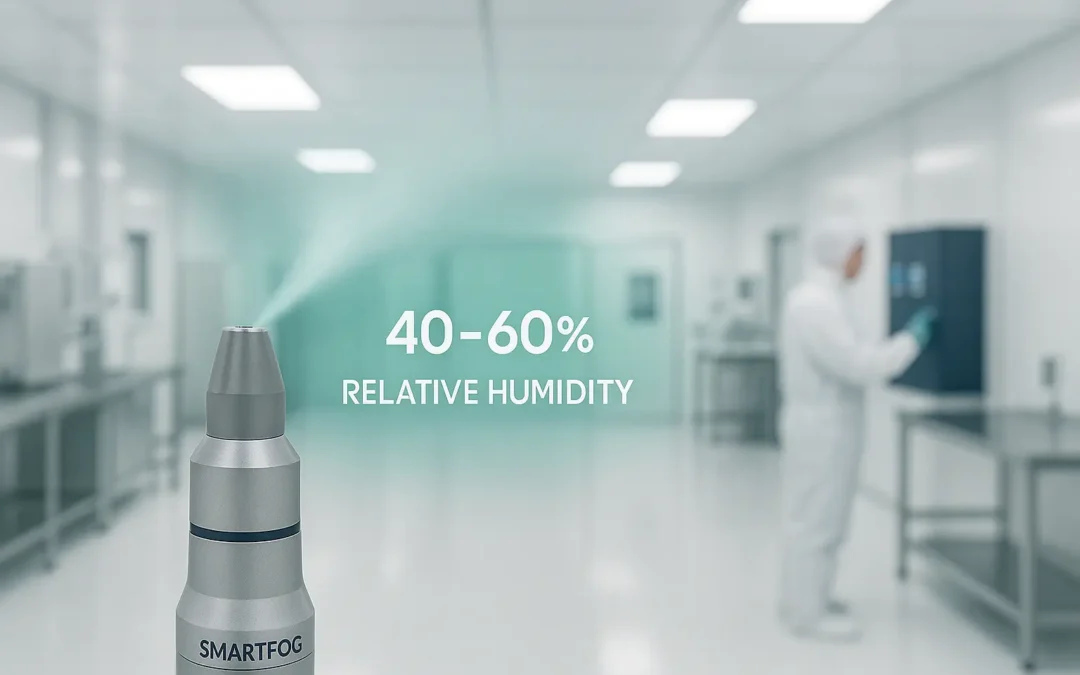Imagine this: a multi-million dollar batch of microchips, flawless in design, fails final inspection. The culprit isn’t a flaw in the manufacturing process or a lapse in protocol, but an invisible force—an electrostatic discharge (ESD) event sparked in the ultra-dry air. The cleanroom’s state-of-the-art HVAC system was running perfectly, yet it couldn’t prevent the catastrophic loss.
This scenario isn’t science fiction; it’s a costly reality in controlled environments. The root cause is often a fundamental misunderstanding. We assume our HVAC system has humidity covered, but true environmental control isn’t about having two separate systems—HVAC and humidification—working in the same room. It’s about creating a single, seamlessly integrated ecosystem. This guide is your blueprint for achieving that synergy.
Foundation: The Science of Cleanroom Humidity
In a cleanroom, humidity isn’t about comfort; it’s a critical process variable as important as temperature and particle count. Getting it wrong can quietly sabotage your entire operation. The key is to understand two core concepts:
- Relative Humidity (RH): This is the measure everyone knows—the amount of water vapor in the air, expressed as a percentage of the maximum amount the air could hold at that temperature.
- Dew Point: This is the temperature at which air becomes saturated (100% RH) and water vapor condenses into liquid. This is the temperature you must stay above to prevent condensation on sensitive surfaces.
For most cleanrooms, the “Goldilocks Zone” for RH is typically between 30% and 50%. Straying outside this narrow band invites two distinct threats:
- Too Low (Below 30% RH): The air becomes an electrical insulator, creating a perfect storm for ESD. Static charges build up on surfaces and personnel, ready to discharge and destroy sensitive electronics. Dry air also allows microscopic particles to remain airborne for longer, increasing contamination risks.
- Too High (Above 60% RH): The environment becomes a breeding ground for bacteria, mold, and mildew. It can also accelerate metal corrosion and degrade sensitive chemical compounds.
Understanding the delicate balance of clean room humidity is the first step toward mastering your controlled environment.

This infographic clarifies how relative humidity and dew point impact cleanroom safety and product integrity by affecting electrostatic discharge and microbial growth risks.
The Integration Gap: Why Your HVAC System Isn’t Enough
A common and costly assumption is that the “H” in HVAC (Heating, Ventilation, and Air Conditioning) is sufficient for precise humidity control. While most commercial HVAC systems have some dehumidification capability, they are rarely equipped to deliver the consistent, narrow-band humidification required by a cleanroom.
Cleanroom HVAC systems are engineering marvels designed for two primary jobs: massive air filtration (via HEPA or ULPA filters) and maintaining strict pressure differentials to prevent contaminant intrusion. They achieve this through extremely high air changes per hour (ACH), constantly cycling the room’s entire air volume.
This high rate of air exchange makes stable humidity control a significant challenge. The HVAC system’s own cooling and heating cycles can cause wild swings in RH. Adding a standalone humidifier without proper integration is like having two pilots trying to fly the same plane without communicating—they will inevitably fight for control, leading to instability, energy waste, and potential condensation.
Building: The Integration Blueprint
Seamless integration isn’t about plugging in a humidifier; it’s a systematic process of designing a unified environmental control system. Following this blueprint ensures your humidification and HVAC systems work in concert, not in conflict.

This flowchart breaks down the complex integration process into clear, manageable steps, boosting confidence in planning and execution.
Step 1: Choosing the Right Humidifier Technology
Not all industrial humidifiers are suitable for cleanrooms. The technology must provide precise control without introducing contaminants. The primary types of humidifiers for HVAC systems in this context include:
- Steam/Isothermal: Boils water to create sterile steam. It’s effective but adds a significant heat load to the space, forcing the HVAC system to work harder to cool the air, increasing energy costs.
- Ultrasonic: Uses high-frequency vibrations to create a fine mist. These systems can be efficient, but if the water isn’t perfectly pure, they can aerosolize minerals and other contaminants directly into the cleanroom.
- Adiabatic/Atomizing: Uses compressed air or high pressure to shatter water into a micro-fine “dry fog.” These droplets evaporate instantly without wetting surfaces. A key benefit of adiabatic humidification is its evaporative cooling effect, which can actually reduce the cooling load on the HVAC system, saving energy.
Step 2: Calculating Your Humidification Load
Before selecting a system, you must know how much moisture you need to add to the air. This “humidification load” is influenced by:
- Cleanroom Size: The total volume of the space.
- Air Change Rate (ACH): How many times the HVAC system replaces the air per hour.
- External Climate: The humidity of the incoming makeup air.
- Internal Heat Sources: Equipment and personnel generate heat that dries the air.
- Material Properties: Some materials absorb or release moisture.
Accurately calculating this load is critical for sizing your system correctly. An undersized system will struggle to keep up, while an oversized one can be inefficient and difficult to control.
Step 3: Strategic Placement of Humidifiers and Sensors
Where you put your equipment is as important as what you choose.
- In-Duct Integration: This is the most common approach. The humidifier is installed directly into the HVAC ductwork, treating the air before it enters the cleanroom. This ensures uniform distribution.
- In-Room Systems: For targeted control in specific zones or in rooms where ductwork is inaccessible, direct in-room systems can be deployed.
- Sensor Placement: This is a point of frequent failure. Humidity sensors must be placed in a representative area of the cleanroom, away from direct airflow from vents, doorways, or heat-generating equipment. Bad sensor placement provides faulty data, leading to flawed control.
Step 4: The Synchronization Challenge: Integrating Controls
This is the most critical and often overlooked step. The humidifier’s control system and the Building Management System (BMS) or primary HVAC controller must communicate. This is typically achieved through standard protocols like Modbus or BACnet.
Proper synchronization ensures a unified strategy. For example, the system knows not to inject humidity while the HVAC is in a strong cooling cycle, preventing condensation. Instead of two systems reacting to each other’s outputs, they work from the same data and toward the same goal: maintaining the environment within your precise specifications.
Mastery: Advanced Considerations & Troubleshooting
Once your system is designed, mastering its operation involves attention to detail and proactive problem-solving.
Water Quality is Non-Negotiable
Using tap water in a cleanroom humidifier is a recipe for disaster. The dissolved minerals and potential microbes will be aerosolized and distributed throughout your pristine environment. A dedicated system using deionized (DI) or reverse osmosis (RO) water is mandatory. Proper water treatment for humidifiers is not just a best practice; it’s essential for preventing contamination and ensuring the longevity of your equipment.
Common Integration Problems and Solutions
Even well-designed systems can face challenges. If you see signs that your humidification system is failing, the issue is often related to integration:
- Problem: Humidity Cycling: The RH level swings wildly above and below the setpoint.
- Likely Cause: Poor sensor placement giving inaccurate feedback, or the control logic between the HVAC and humidifier is fighting.
- Solution: Verify sensor location and calibrate. Ensure the control systems have a shared deadband and are not working against each other.
- Problem: Condensation or “Wetting”: Moisture is appearing on surfaces.
- Likely Cause: The humidifier is producing droplets that are too large, or the air is becoming oversaturated. This can happen if the humidifier is injecting moisture while the air temperature is dropping rapidly.
- Solution: Use a humidifier that guarantees a non-wetting, evaporative fog. Refine control logic to prevent humidification during aggressive cooling cycles.
- Problem: Control System Conflicts: The BMS is commanding one action while the humidifier’s local controller is doing another.
- Likely Cause: A breakdown in communication protocol or an incorrect master/slave hierarchy.
- Solution: Conduct a full controls audit to ensure there is a single point of command and that all systems are responding correctly.
Action: Your Integration Checklist
To ensure a successful integration project, use this checklist to guide your planning and execution.

This checklist anchors critical integration tasks visually, serving as a quick-reference memory aid for professionals to ensure nothing is overlooked.
Frequently Asked Questions (FAQ)
What are the ideal humidity levels for a cleanroom?While this varies by application, a general target for many industries, including pharmaceuticals and electronics, is 30-50% RH. The key is consistency. A stable 45% is far better than fluctuating between 35% and 55%.
How does humidity affect HEPA filter performance?High humidity (above 60% RH) can promote microbial growth on the filter media itself, turning your filtration system into a source of contamination. Proper integration ensures the air is treated correctly before it passes through the final filters, protecting their integrity.
Can any industrial humidifier be used in a cleanroom?Absolutely not. Cleanroom humidifiers must be specifically designed to be non-contaminating. This means they should not introduce minerals, particulates, or microbes into the air. Technologies that use deionized water and produce a completely evaporated fog, like the Smart Fog ES100, are purpose-built for these sensitive environments.
What maintenance is required for integrated humidification systems?This depends heavily on the technology. Steam systems may require periodic descaling, and ultrasonic systems need diligent cleaning to prevent microbial buildup. Advanced atomizing systems with no moving parts or heating elements require minimal maintenance, often only involving periodic filter changes on the water supply line.
The Path to a Perfectly Controlled Environment
Achieving precise environmental control in a cleanroom is a complex challenge that extends far beyond the HEPA filter. It demands a holistic approach where the humidification system is not an accessory, but a fully integrated component of your HVAC infrastructure.
By moving from a mindset of separate components to one of a single, intelligent ecosystem, you can eliminate the invisible threats of ESD and contamination, enhance product yield, and create a truly stable and predictable controlled environment. Exploring the specific humidification needs of cleanrooms is the critical next step in mastering your facility’s performance.



